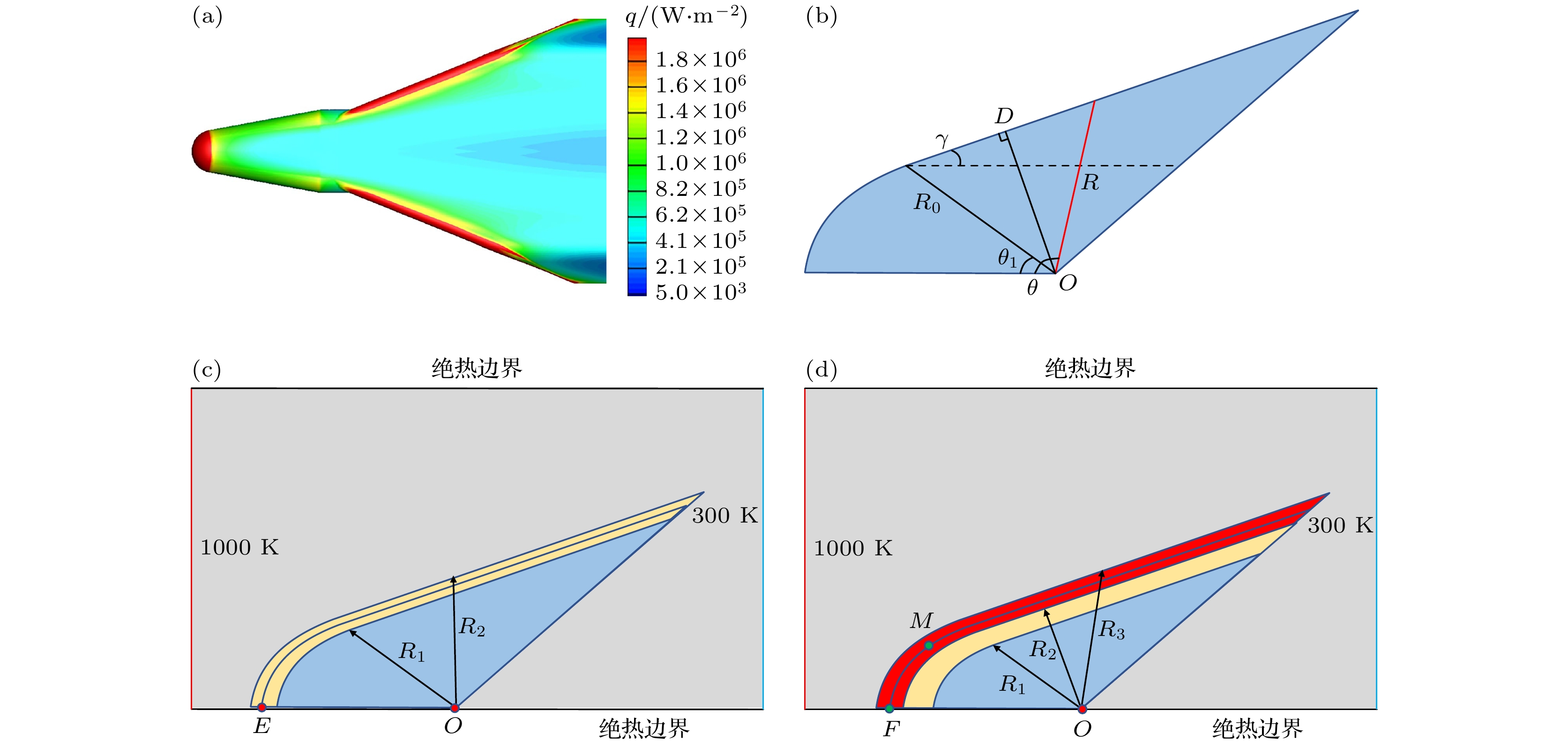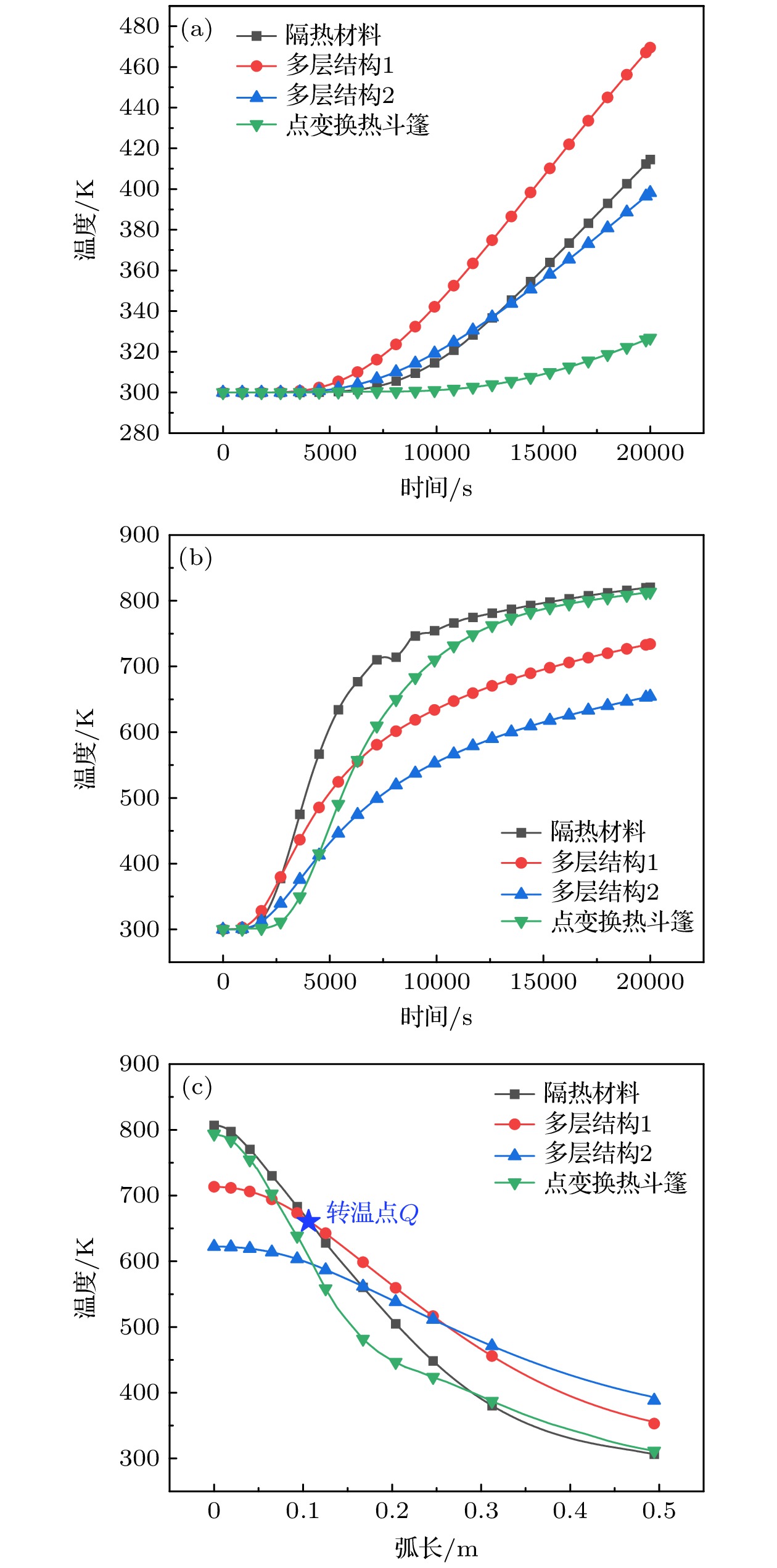-
高超声速飞行器在飞行过程中产生大量气动热, 高效的热防护技术对保证其正常工作具有重要意义. 本文基于热超材料调控热流传播路径思想, 针对高超声速飞行器头锥, 采用坐标变换法设计非封闭式点变换热斗篷及简化近似的多层结构. COMSOL数值模拟研究表明, 两种结构均有效实现导热和辐射热流的热绕流, 使部分热量沿头锥表面传播, 头锥前端温度显著降低, 机体升温速率减缓. 但其热防护性能的提升要求材料固相和辐射热导率低于原隔热材料. 进一步设计了非封闭式域变换热斗篷, 材料固相和辐射热导率均可高于原隔热材料. 模拟结果表明, 热绕流显著提升了域变换热斗篷的热防护能力, 相比于纯隔热材料, 头锥前端温度降低达100 K, 机体降温达10 K, 展现出重要的热防护应用潜力.The aerodynamic heat of hypersonic vehicle nose cone can reach tens of MW/m2 during flight, which could be transferred to the interior of hypersonic vehicle in the form of conduction and radiation. High efficient thermal insulation technology is of significance in keeping internal electronic components working safely. Thermal metamaterials can regulate the macroscopic heat flow path, and they are developing rapidly and have a wide application prospect in the field of thermal protection. In this work, a non-enclosed point transformation thermal cloak is designed to guide heat flow around hypersonic vehicle nose cone by using the transformation multithermotics, which can control thermal conduction and radiation simultaneously. A multi-layer structure is designed as cloak’s simplified approximation due to the anisotropic parameters. Based on the software COMSOL, the thermal protection characteristics and heat transfer mechanism of the point transformation cloak and multi-layer structure are studied numerically. The results show that heat can flow around the object in the form of conduction and radiation in both point transformation thermal cloak and multi-layer structure, so the heat transferred to the inner area decreases. Comparing with the thermal insulation material, the heating rate of the protected area slows down, and the temperature in the front of the hypersonic vehicle nose cone is significantly reduced. However, the improvement of the thermal protection performance of point transformation cloak and multi-layer structures requires that the solid thermal conductivity and radiative thermal conductivity of the material are lower than those of the original thermal insulation material. To solve this problem, a non-enclosed region transformation thermal cloak is further proposed. The solid thermal conductivity and radiative thermal conductivity of region transformation thermal cloak are non-singular, which could be higher than those of the original thermal insulation material. Numerical simulation results show that the region transformation thermal cloak can guide heat flow around object, so the thermal protection capability is improved significantly. Comparing with the thermal insulation materials, the temperature of the front of the hypersonic vehicle nose cone is reduced by 100 K, and the temperature of the inner central zone of the hypersonic vehicle nose cone is reduced by 10 K. The non-enclosed region transformation thermal cloak provides a new approach to realizing thermal protection and is suitable for complex target areas, showing great application potential in thermal protection.
-
Keywords:
- thermal metamaterial /
- coordinate transformation /
- COMSOL /
- thermal protection
[1] 杜晨慧 2023 装备环境工程 20 43
Du C H 2023 Equip. Environ. Eng. 20 43
[2] 桂业伟, 刘磊, 魏东 2020 空气动力学报 38 641
 Google Scholar
Google Scholar
Gui Y W, Liu L, Wei D 2020 Acta Aerod. Sin. 38 641
 Google Scholar
Google Scholar
[3] 谢永旺, 夏雨, 许学伟, 李峥, 陆浩, 许孔力 2022 空天技术 4 73
 Google Scholar
Google Scholar
Xie Y W, Xia Y, Xu X W, Li Z, Lu H, Xu K L 2022 Aerosp. Technol. 4 73
 Google Scholar
Google Scholar
[4] Su H, Wang J H, He F, Chen L, Ai B C 2019 Int. J. Heat Mass Transfer 129 480
 Google Scholar
Google Scholar
[5] Bohrk H 2015 J. Spacecr. Rockets 52 674
 Google Scholar
Google Scholar
[6] 栾芸, 贺菲, 王建华 2023 推进技术 44 22010020
 Google Scholar
Google Scholar
Luan Y, He F, Wang J H 2023 J. Propul. Technol. 44 22010020
 Google Scholar
Google Scholar
[7] Liu H P, Liu W Q 2016 Acta Astronaut. 118 210
 Google Scholar
Google Scholar
[8] 陈连忠, 欧东斌 2010 实验流体力学 24 51
 Google Scholar
Google Scholar
Chen L Z, Ou D B 2010 J. Exp. Fluid Mech. 24 51
 Google Scholar
Google Scholar
[9] 李健, 张凡, 张丽娟, 李文静, 赵英民 2019 北京理工大学学报 39 1051
 Google Scholar
Google Scholar
Li J, Zhang F, Zhang L J, Li W J, Zhao Y M 2019 Trans. Beijing Inst. Technol. 39 1051
 Google Scholar
Google Scholar
[10] 王飞, 王秦阳, 孙创, 康宏琳 2023 航空动力学报 38 1075
 Google Scholar
Google Scholar
Wang F, Wang Q Y, Sun C, Kang H L 2023 J. Aerosp. Power 38 1075
 Google Scholar
Google Scholar
[11] 瑚佩, 姜勇刚, 张忠明, 冯军宗, 李良军, 冯坚 2020 材料导报 34 07082
 Google Scholar
Google Scholar
Hu P, Jiang Y G, Zhang Z M, Feng J Z, Li L J, Feng J 2020 Mater. Rep. 34 07082
 Google Scholar
Google Scholar
[12] 苟建军, 肖爽, 胡嘉欣, 高戈, 龚春林 2022 宇航学报 43 983
 Google Scholar
Google Scholar
Gou J Z, Xiao S, Hu J X, Gao G, Gong C L 2022 J. Astronaut. 43 983
 Google Scholar
Google Scholar
[13] 赵越 2015 博士学位论文(西安: 西安交通大学)
Zhao Y 2015 Ph. D. Dissertation (Xi’an: Xi’an Jiaotong University
[14] Fan C Z, Gao Y, Huang J P 2008 Appl. Phys. Lett. 92 251907
 Google Scholar
Google Scholar
[15] Guenneau S, Amra C, Veynante D 2012 Opt. Express 20 8207
 Google Scholar
Google Scholar
[16] Narayana S, Sato Y 2012 Phys. Rev. Lett. 108 214303
 Google Scholar
Google Scholar
[17] Lou Q, Xia M G 2023 Chin. Phys. Lett. 40 094401
 Google Scholar
Google Scholar
[18] Zhang J, Zhang H C, Huang Z L, Sun W B, Li Y Y 2022 Chin. Phys. B 31 014402
 Google Scholar
Google Scholar
[19] Narayana S, Savo S, Sato Y 2013 Appl. Phys. Lett. 102 201904
 Google Scholar
Google Scholar
[20] Xu L J, Dai G L, Huang J P 2020 Phys. Rev. Appl. 13 024063
 Google Scholar
Google Scholar
[21] Yang S, Wang J, Dai G L, Yang F B, Huang J P 2021 Phys. Rep. 908 1
 Google Scholar
Google Scholar
[22] He B, Yang W, Liu F H 2019 Appl. Math. Lett. 94 99
 Google Scholar
Google Scholar
[23] Maleki H 2016 Chem. Eng. J. 300 98
 Google Scholar
Google Scholar
[24] 黄诗瑶 2021硕士学位论文(武汉: 华中科技大学)
Huang S Y 2021 M. S. Thesis (Wuhan: Huazhong University of Science and Technology
[25] 聂春生, 黄建栋, 王迅, 李宇 2017 空气动力学报 35 760
 Google Scholar
Google Scholar
Nie C S, Huang J D, Wang X, Li Y 2017 Acta Aerod. Sin. 35 760
 Google Scholar
Google Scholar
[26] 姜志杰 2008 硕士学位论文 (长沙: 国防科技大学)
Jiang Z J 2008 M. S. Thesis (Changsha: National University of Defense Technology
[27] Sha W, Xiao M, Zhang J H, Ren X C, Zhu Z, Zhang Y, Xu G Q, Li H G, Liu X L, Chen X, Gao L, Qiu C W, Hu R 2021 Nat. Commun. 12 7228
 Google Scholar
Google Scholar
[28] Vemuri K P, Bandaru P R 2013 Appl. Phys. Lett. 103 133111
 Google Scholar
Google Scholar
[29] Ji Q X, Qi Y C, Liu C W, Meng S H, Liang J, Kadic M, Fang G D 2022 Int. J. Heat Mass Transfer 189 122716
 Google Scholar
Google Scholar
-
图 4 域变换热斗篷热防护特性 (a) O点升温曲线; (b) F点升温曲线; (c)曲线R = 0.96R3温度分布; (d) M点热流密度变化曲线
Fig. 4. Thermal protection characteristics of region transformation thermal cloak: (a) Temperature variation at point O against time; (b) temperature variation at point F against time; (c) temperature profile on the curve R = 0.96R3; (d) heat flux at point M against time.
-
[1] 杜晨慧 2023 装备环境工程 20 43
Du C H 2023 Equip. Environ. Eng. 20 43
[2] 桂业伟, 刘磊, 魏东 2020 空气动力学报 38 641
 Google Scholar
Google Scholar
Gui Y W, Liu L, Wei D 2020 Acta Aerod. Sin. 38 641
 Google Scholar
Google Scholar
[3] 谢永旺, 夏雨, 许学伟, 李峥, 陆浩, 许孔力 2022 空天技术 4 73
 Google Scholar
Google Scholar
Xie Y W, Xia Y, Xu X W, Li Z, Lu H, Xu K L 2022 Aerosp. Technol. 4 73
 Google Scholar
Google Scholar
[4] Su H, Wang J H, He F, Chen L, Ai B C 2019 Int. J. Heat Mass Transfer 129 480
 Google Scholar
Google Scholar
[5] Bohrk H 2015 J. Spacecr. Rockets 52 674
 Google Scholar
Google Scholar
[6] 栾芸, 贺菲, 王建华 2023 推进技术 44 22010020
 Google Scholar
Google Scholar
Luan Y, He F, Wang J H 2023 J. Propul. Technol. 44 22010020
 Google Scholar
Google Scholar
[7] Liu H P, Liu W Q 2016 Acta Astronaut. 118 210
 Google Scholar
Google Scholar
[8] 陈连忠, 欧东斌 2010 实验流体力学 24 51
 Google Scholar
Google Scholar
Chen L Z, Ou D B 2010 J. Exp. Fluid Mech. 24 51
 Google Scholar
Google Scholar
[9] 李健, 张凡, 张丽娟, 李文静, 赵英民 2019 北京理工大学学报 39 1051
 Google Scholar
Google Scholar
Li J, Zhang F, Zhang L J, Li W J, Zhao Y M 2019 Trans. Beijing Inst. Technol. 39 1051
 Google Scholar
Google Scholar
[10] 王飞, 王秦阳, 孙创, 康宏琳 2023 航空动力学报 38 1075
 Google Scholar
Google Scholar
Wang F, Wang Q Y, Sun C, Kang H L 2023 J. Aerosp. Power 38 1075
 Google Scholar
Google Scholar
[11] 瑚佩, 姜勇刚, 张忠明, 冯军宗, 李良军, 冯坚 2020 材料导报 34 07082
 Google Scholar
Google Scholar
Hu P, Jiang Y G, Zhang Z M, Feng J Z, Li L J, Feng J 2020 Mater. Rep. 34 07082
 Google Scholar
Google Scholar
[12] 苟建军, 肖爽, 胡嘉欣, 高戈, 龚春林 2022 宇航学报 43 983
 Google Scholar
Google Scholar
Gou J Z, Xiao S, Hu J X, Gao G, Gong C L 2022 J. Astronaut. 43 983
 Google Scholar
Google Scholar
[13] 赵越 2015 博士学位论文(西安: 西安交通大学)
Zhao Y 2015 Ph. D. Dissertation (Xi’an: Xi’an Jiaotong University
[14] Fan C Z, Gao Y, Huang J P 2008 Appl. Phys. Lett. 92 251907
 Google Scholar
Google Scholar
[15] Guenneau S, Amra C, Veynante D 2012 Opt. Express 20 8207
 Google Scholar
Google Scholar
[16] Narayana S, Sato Y 2012 Phys. Rev. Lett. 108 214303
 Google Scholar
Google Scholar
[17] Lou Q, Xia M G 2023 Chin. Phys. Lett. 40 094401
 Google Scholar
Google Scholar
[18] Zhang J, Zhang H C, Huang Z L, Sun W B, Li Y Y 2022 Chin. Phys. B 31 014402
 Google Scholar
Google Scholar
[19] Narayana S, Savo S, Sato Y 2013 Appl. Phys. Lett. 102 201904
 Google Scholar
Google Scholar
[20] Xu L J, Dai G L, Huang J P 2020 Phys. Rev. Appl. 13 024063
 Google Scholar
Google Scholar
[21] Yang S, Wang J, Dai G L, Yang F B, Huang J P 2021 Phys. Rep. 908 1
 Google Scholar
Google Scholar
[22] He B, Yang W, Liu F H 2019 Appl. Math. Lett. 94 99
 Google Scholar
Google Scholar
[23] Maleki H 2016 Chem. Eng. J. 300 98
 Google Scholar
Google Scholar
[24] 黄诗瑶 2021硕士学位论文(武汉: 华中科技大学)
Huang S Y 2021 M. S. Thesis (Wuhan: Huazhong University of Science and Technology
[25] 聂春生, 黄建栋, 王迅, 李宇 2017 空气动力学报 35 760
 Google Scholar
Google Scholar
Nie C S, Huang J D, Wang X, Li Y 2017 Acta Aerod. Sin. 35 760
 Google Scholar
Google Scholar
[26] 姜志杰 2008 硕士学位论文 (长沙: 国防科技大学)
Jiang Z J 2008 M. S. Thesis (Changsha: National University of Defense Technology
[27] Sha W, Xiao M, Zhang J H, Ren X C, Zhu Z, Zhang Y, Xu G Q, Li H G, Liu X L, Chen X, Gao L, Qiu C W, Hu R 2021 Nat. Commun. 12 7228
 Google Scholar
Google Scholar
[28] Vemuri K P, Bandaru P R 2013 Appl. Phys. Lett. 103 133111
 Google Scholar
Google Scholar
[29] Ji Q X, Qi Y C, Liu C W, Meng S H, Liang J, Kadic M, Fang G D 2022 Int. J. Heat Mass Transfer 189 122716
 Google Scholar
Google Scholar
计量
- 文章访问数: 5532
- PDF下载量: 253
- 被引次数: 0














 下载:
下载:



